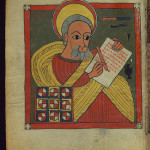We run our website the way we wished the whole internet worked: we provide high quality original content with no ads. We are funded solely by your direct support. Please consider supporting this project.
Greg’s Response to Driscoll’s “Is God a Pacifist?” Part II
Waiting For The Word via Compfight
To prove that “Jesus is not a pansy or a pacifist,” Driscoll by-passes the Gospels (understandably, given what Jesus has to say about the use of violence) and instead cites a passage from Revelation. This is a strategy Driscoll has used before. In an interview in Relevant Magazine several years ago, Driscoll argued that, “[i]n Revelation, Jesus is a pride fighter with a tattoo down His leg, a sword in His hand and the commitment to make someone bleed.” He went on record as saying that he could worship this image of Jesus because “I could never worship a guy I could beat up.” (Didn’t he already crucify him?)
Before addressing the specific passage in question (in my next post), I want to outline four aspects of the book of Revelation that Driscoll overlooks as he uses this book to ground his violent view of Jesus.
First, it can’t be denied that if you interpret Revelation as a literal snapshot of what is going to take place the last couple years of world history, you’ll find a Jesus who appears violent. But it’s also true that the apocalyptic genre of this book completely rules out a literal reading, as virtually all NT scholars acknowledge. And if a person nevertheless insists on reading Revelation this way, they’ll find they quickly run into problems.
To give one small example, as a new Christian in a fundamentalist church who was taught to interpret Revelation (and everything else in Scripture) literally, I recall becoming deeply puzzled when I read that stars at one point fell from the sky “to the earth, like figs” (6:13). How those enormous balls of burning gas could fall to the earth at all, let alone like figs, was problematic, but not nearly as problematic as when I discovered they had somehow gotten back into the sky two chapters later when a third were darkened (8:12). My bewilderment only increased when I found several chapters later that the stars were all back up there again, but a third were once again wiped out by the tail of a dragon (12:4). If taken literally, we find contradictions such as this permeate this book. If we instead interpret Revelation in ways that are appropriate to the apocalyptic genre, realizing that it uses highly symbolic images for an emotive effect, these sorts of contradictions are not only not problematic, they are to be expected.
As an analogy to the importance of paying attention to the genre of Revelation, consider the way we interpret political cartoons. Imagine if someone from another culture who was completely unfamiliar with this genre of writing happened to come upon one of these. Without an understanding of the way this genre of writing employs talking animals (e.g. Donkeys and Elephants) and exaggerated body types as satirical devices, they might assume that the artist actually thought animals talked and that President Obama actually had ears bigger than his head! Interpreting Revelation as though it is a straightforward preview of a future period of time distorts its meaning no less than this person was misunderstanding the political cartoon. Unfortunately, Driscoll’s use of Revelation, at least when he’s trying to prove “Jesus was not a pansy or a pacifist,” is premised on just this misunderstanding. I would encourage him to familiarize himself with this genre before basing any further public arguments on it.
Second, the most ingenious aspect of this book is the manner in which John takes familiar violent images from the OT (as well as some from other apocalyptic literature) and turns them on their head to reverse their original meaning. The most important example of this is when John introduces the Messiah, who alone is “worthy to open the scroll,” as a “lion” (Rev 5:5, from Gen. 49:9; Isa 11:1-5). This image brings to mind the violent, militaristic, triumphalist image of a Messiah who would defeat enemies by ripping them apart – along the lines of Driscoll’s “pride fighter.” Yet, when John looks again, he sees that the lion has become “a Lamb, looking as if it had been slain.” (5:6). By identifying the lion as a slain Lamb, John has transformed a “symbol of power and domination” into a “symbol of vulnerability and nonviolence.”[1] And from this point on, it is the slain Lamb, not the lion, who does all the fighting, and if you read this book carefully, you’ll see he always does it in a slain-Lamb-like way, triumphing through “vulnerability and nonviolence.”
At every turn, John transforms violent images into images of anti-violence. As a second example, consider the scene of the final (and bloodiest) battle in this book (Rev. 19:11-12). We find the Messiah “dressed in a robe, dipped in blood” (Rev. 19:13). This is a classic warrior image of a valiant warrior who comes riding home from battle soaked in the blood of all those he’s slain (e.g Isa 63:1-3). The interesting thing is that Jesus is soaked in blood as he rides into battle! What kind of warrior is soaked in blood before he fights? The kind of warrior who fights in a slain-lamb-way! John is revealing that the Lamb defeats foes not by shedding his enemies blood, but by shedding his own blood on behalf of his enemies.
A third important symbol that John transforms in a non-violent direction is the sword. Driscoll was right to claim that the Jesus of Revelation carries a sword, but he was very mistaken in claiming he carried it in his hand. The sword that the slain Lamb carries as he rides into battle on a horse is one that comes out of his mouth (19:15, 21; cf. 1:16; 2:12,16;). Taken literally, the image is of course comical. (One would also wonder why Jesus and his army would fight a 21st [or later] century battle on horses instead of (say) military Hummers.) If we embrace the image in all of its symbolism, however, the meaning is profound. By placing the sword in the mouth of the slain Lamb, John is reversing its violent meaning. He is signifying that the Lamb warrior fights not by shedding blood, but simply by speaking the truth of God, thereby slaying the lies of the “deceiver” who had held these nations in bondage (19:20). This is why John states that the name of this warrior was “the Word of God” (19:13).
Along similar lines, it’s obvious that Jesus didn’t kill anyone with his sword, for immediately after saying Jesus struck down the nations, John proclaims that Jesus was now going to “rule them with an iron scepter” (Rev. 19: 15). Moreover, we later find these “slain nations” walking by the light of the Lamb, with their kings bringing the splendor of their nations into the heavenly city (Rev 21:24). Having slain the nations that were deceived by Satan’s lies, the Lamb had set them free to see the truth. This is the kind of warfare the Lamb engages in.
In fact, the battle that runs throughout Revelation is a battle between the Lamb who is “faithful and true” (14:5; cf. 3:14), manifesting the truth of God’s loving, self-sacrificial character and way of defeating evil, and Satan, “the deceiver” who “leads the whole world astray” with the lie that the coercive power of the empire (Babylon) will win the day (Rev. 12:9, cf. 20:2-3, 7-8). And the central purpose of Revelation is to call God’s people, who are facing immanent persecution, to remain faithful to God’s Lamb-like character, despite the appearance that this way of living loses in the face of the coercive power of Babylon.
This relates to the final violent image that John transforms. The slain Lamb has an army, which is, of course, his church. But it’s a most peculiar kind of army, just as the Lamb is a most peculiar kind of warrior. For this army conquers by “following the Lamb wherever he goes” as they are “offered as first fruits to God and the Lamb”(14:8). So too, this army is victorious because they “have washed their robes and made them white in the blood of the Lamb”(7:14), which Bauckham and others interpret to mean “they are martyrs, who have triumphed by participating, through their own deaths, in the sacrificial death of the Lamb.”[2] And this peculiar army triumphs over the devil “by the blood of the Lamb and by the word of their testimony,” for “they did not love their lives so much as to shrink from death” (Rev. 12:10).
In short, this army fights and wins the exact same way the slain Lamb who leads them fights and wins: not by slaying foes, but by remaining faithful to the point of laying down their lives for others. This is why martyrdom is such a pervasive theme throughout this book (e.g. 6.9-10; 7:14; 12:11; 13:15; 18:12). By means of imitating the Lamb – “following [him] wherever he goes,” God’s people bear witness to the truth of God’s self-sacrificial character and his loving way of overcoming evil, just as the Lamb does. And in this way they vanquish the lie of Satan that leads the whole world astray, deceiving them to place their trust in the empire’s coercive kind of power.
In this light, I think it’s clear that Driscoll’s misguided literal reading of Revelation has caused him to ascribe to John’s imagery the exact opposite meaning that John intends. And the reason is that Driscoll has grasped the violent images while completely overlooking the masterful way John reverses their meaning. And it’s for this reason that Driscoll concludes that Revelation depicts Jesus as “a pride fighter with a…sword in His hand and the commitment to make someone bleed” rather than a slain Lamb with the sword of truth coming out of his mouth and a commitment to shed his own blood on behalf of others.
In the final post in this three part series we’ll explore the way Driscoll’s literalistic approach causes him to once again read the exact opposite meaning into Revelation 14: 14-20.
Related Reading

The Bible, Government and Christian Anarchy
This “essay” contains my informal reflections on biblical texts that I believe support what some call “Christian Anarchy.” Consider it a very rough draft of a future project. I’ll argue that Kingdom people are called to pledge their allegiance to God alone, not to any nation, government, political party or ideology. Because Kingdom people are…

Podcast: If Violence is Wrong, Why Passively Allow Others to Use It?
Greg discusses dealing with the violence of loved ones. http://traffic.libsyn.com/askgregboyd/Episode_0166_.mp3

An Author Repents
In 1969, 19 year old William Powell wrote the now classic The Anarchist Cookbook. He was very angry at the time that the US military was pursuing him to fight in the Vietnam War. It’s basically a “how-to” book on surviving a violent government action against its own citizens. Today William is on a very…

Are the Gospels Historical Fiction?
Some scholars today argue that the stories recorded in the Gospels are actually intentional fabrication. In essence, they argue that Mark took Paul’s theology and robed the story of Jesus in a fictitious historical narrative. The other Gospels followed suit. The argument is clever and removes the difficulty of explaining how a legend of a…

God, Why You So Harsh in Revelation? (podcast)
Greg talks about Jezebels and beds of suffering. Episode 512 http://traffic.libsyn.com/askgregboyd/Episode_0512.mp3

Why Did Jesus Curse the Fig Tree?
One of the strangest episodes recorded in the Gospels is Jesus cursing a fig tree because he was hungry and it didn’t have any figs (Mk 11:12-14; Mt 21:18-19). It’s the only destructive miracle found in the New Testament. What’s particularly puzzling is that Mark tells us the reason the fig tree had no figs…

